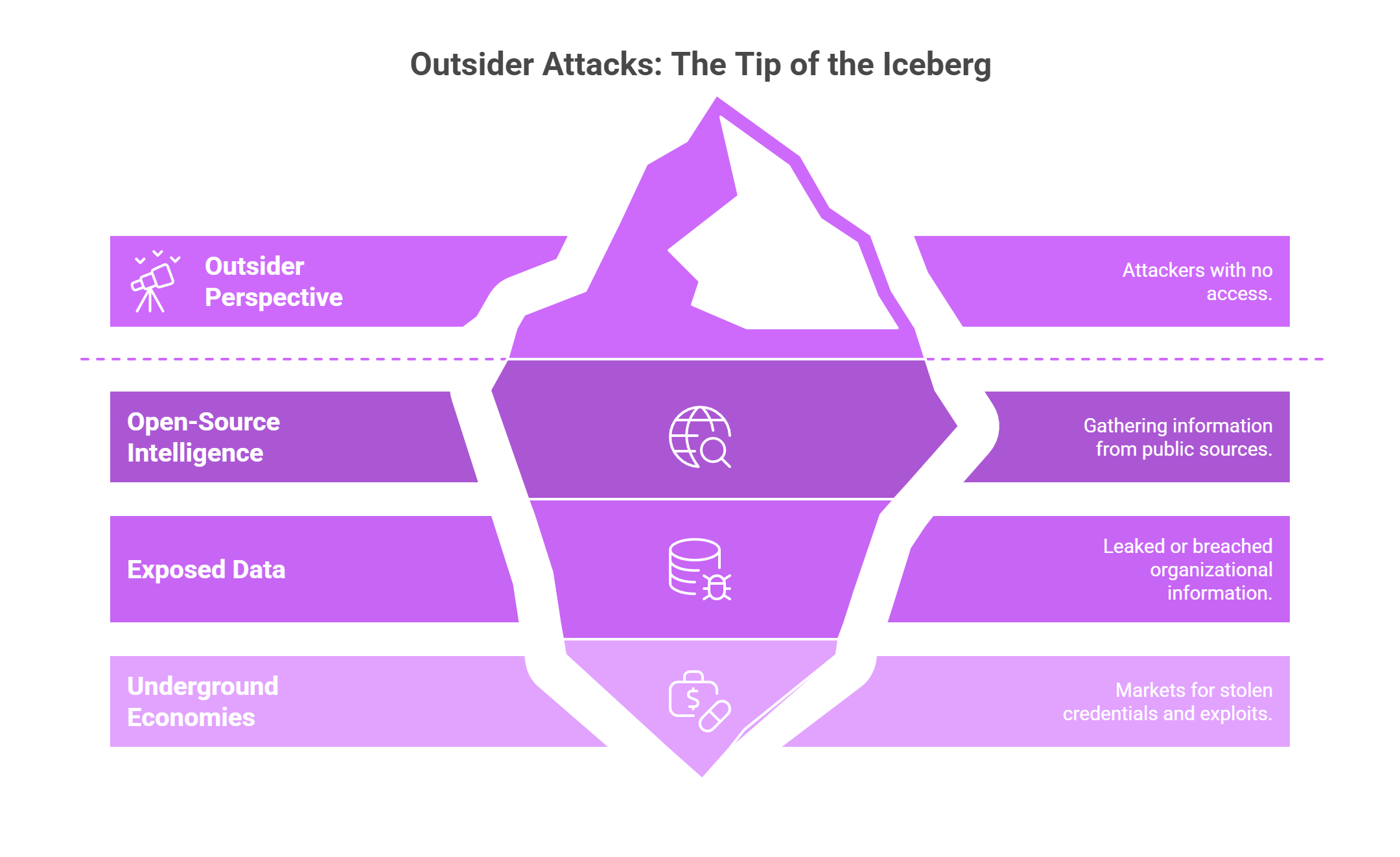Outsider Initial Access
The outsider perspective represents the most common entry point for real-world attackers.
An outsider has no legitimate access to the organization but leverages open-source intelligence, exposed data, and underground economies to gain an initial foothold.
In the modern threat landscape, data leaks and access markets have become one of the most powerful enablers for this phase.
The Economy of Leaks and Initial Access
Over the last decade, stolen credentials and corporate access have evolved into a full-fledged underground economy.
Instead of relying solely on custom exploits, many attackers now purchase ready-to-use access on dedicated platforms known as Initial Access Brokers (IABs).
These marketplaces sell credentials, VPN sessions, RDP access, and even entire domain admin accounts obtained through:
- Infostealer malware (Raccoon Stealer, RedLine, Vidar, Lumma, etc.)
→ harvesting browser-stored credentials, cookies, and session tokens. - Phishing campaigns
→ collecting valid logins directly from users. - Database breaches
→ password reuse becomes an easy path to corporate compromise. - Compromised infrastructure
→ misconfigured Citrix, exposed VPNs, weak RDP.

For a Red Team, monitoring and simulating this ecosystem provides a realistic attack surface.
Key Marketplaces and Access Brokers
Although many platforms are volatile (shut down or rebranded), some persistent names have shaped the underground access economy:
-
Russian Market:
Specializes in logs from infostealers. Operators can search by domain (e.g.,company.com) and instantly purchase credential sets including cookies, browser fingerprints, and saved passwords. This is one of the fastest ways to simulate realistic credential theft. -
Genesis Market (taken down, but clones exist):
Famous for selling bot profiles — full browser fingerprints and cookies allowing attackers to bypass MFA by impersonating a victim’s session. Even though the original was dismantled, several copycats (e.g., Genesis 2.0) continue to circulate. -
2easy Shop:
Known for its cheap, massive supply of logs. While less curated, it demonstrates the scale of access available to attackers with minimal investment. -
Private IAB forums:
Beyond public shops, some brokers operate in invite-only channels (Telegram, XMPP, closed forums). They sell higher-value accesses such as domain controllers, corporate VPNs, or even cloud admin panels.
⚠️ For a Red Team operator, simulation is the priority.
Actual purchase of illegal access is not necessary; instead, teams may:
- Use OSINT to replicate what is available.
- Leverage pre-collected leaks (public breaches, corporate credential dumps).
- Emulate the workflow of searching and using stolen data, without crossing into criminal acquisition.
Practical Red Team Techniques with Leaks
-
Credential Validation
Once credentials are obtained (from leaks or simulated markets), the first step is to validate them safely:- Test against corporate VPN / webmail portals.
- Check password reuse across exposed accounts.
- Use password spraying with leaked patterns (e.g.,
Winter2024!,Company@123).
-
Cookie and Session Replay
Infostealers often expose cookies (Google Workspace, O365, Salesforce).- Red Teamers can replay sessions to simulate MFA bypass.
- Browser profile emulation tools can mimic a stolen fingerprint.
-
Targeted Enumeration in Leaks
- Searching leaks by email domain (
@company.com). - Looking for executive accounts (CEO, CFO) to simulate whaling.
- Identifying technical staff accounts (admins, developers) which often have privileged access.
- Searching leaks by email domain (
-
Combination with OSINT
Leaks become exponentially more valuable when correlated with OSINT:- Cross-matching LinkedIn employee lists with breach data.
- Identifying developers on GitHub and checking their credentials in leaks.
- Using Shodan/Censys to link leaked accounts with exposed services.
Red Team Scenarios
A realistic outsider-to-insider path often looks like this:
- An attacker finds employee credentials on a leak marketplace.
- The password is reused on the company’s VPN gateway.
- With VPN access, the attacker reaches internal systems.
- From there, enumeration and lateral movement begin.
Or alternatively:
- Cookies from Russian Market allow bypassing MFA on an O365 account.
- The attacker gains access to corporate emails and OneDrive.
- Sensitive documents are exfiltrated without triggering credential alerts.
These are not abstract possibilities — they are daily realities in the access broker ecosystem.
By simulating them, a Red Team provides defenders with true-to-life training and highlights how a single leaked credential can unravel an entire security posture.
Defensive Insights
From a Blue Team perspective, defending against this ecosystem requires:
- Continuous leak monitoring (dark web, Telegram, marketplaces).
- Credential hygiene enforcement: mandatory password rotation, MFA everywhere, prevention of password reuse.
- Anomaly detection: session replay, impossible travel, unusual browser fingerprints.
- User awareness: employees understanding the value of their credentials in underground economies.
Conclusion
The outsider phase is no longer about brute-forcing doors; it’s about walking through ones already left open by leaks and data brokers.
For a Red Team, focusing on leaks and markets provides a highly realistic initial access vector — one that is cheap, scalable, and devastatingly effective in modern adversary simulations.